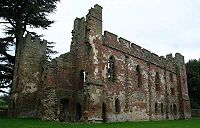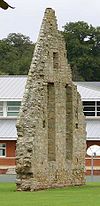
Acton Burnell Castle
Encyclopedia

Manor house
A manor house is a country house that historically formed the administrative centre of a manor, the lowest unit of territorial organisation in the feudal system in Europe. The term is applied to country houses that belonged to the gentry and other grand stately homes...
, located near the village of Acton Burnell
Acton Burnell
Acton Burnell is a village and parish in the English county of Shropshire. It lies at 110m above sea level and is near to Park Wood.-Attractions:...
, Shropshire
Shropshire
Shropshire is a county in the West Midlands region of England. For Eurostat purposes, the county is a NUTS 3 region and is one of four counties or unitary districts that comprise the "Shropshire and Staffordshire" NUTS 2 region. It borders Wales to the west...
, England . It is believed that the first Parliament of England
Parliament of England
The Parliament of England was the legislature of the Kingdom of England. In 1066, William of Normandy introduced a feudal system, by which he sought the advice of a council of tenants-in-chief and ecclesiastics before making laws...
at which the Commons were fully represented was held here in 1283. Today all that remains is the outer shell of the manor house and the gable ends of the barn. It is a Grade I listed building of the Statutory List of Buildings of Special Architectural or Historic Interest.
Initial building

Robert Burnell
Robert Burnell was an English bishop who served as Lord Chancellor of England from 1274 to 1292. A native of Shropshire, he served as a minor royal official before entering into the service of Prince Edward, the future King Edward I of England...
, Bishop of Bath and Wells
Bishop of Bath and Wells
The Bishop of Bath and Wells heads the Church of England Diocese of Bath and Wells in the Province of Canterbury in England.The present diocese covers the vast majority of the county of Somerset and a small area of Dorset. The Episcopal seat is located in the Cathedral Church of Saint Andrew in...
, friend and advisor to King Edward I
Edward I of England
Edward I , also known as Edward Longshanks and the Hammer of the Scots, was King of England from 1272 to 1307. The first son of Henry III, Edward was involved early in the political intrigues of his father's reign, which included an outright rebellion by the English barons...
. Its position was important at the time because it was near to the old Roman road
Roman road
The Roman roads were a vital part of the development of the Roman state, from about 500 BC through the expansion during the Roman Republic and the Roman Empire. Roman roads enabled the Romans to move armies and trade goods and to communicate. The Roman road system spanned more than 400,000 km...
of Watling Street
Watling Street
Watling Street is the name given to an ancient trackway in England and Wales that was first used by the Britons mainly between the modern cities of Canterbury and St Albans. The Romans later paved the route, part of which is identified on the Antonine Itinerary as Iter III: "Item a Londinio ad...
. The extent of the estate is not known, as much of the building has been completely destroyed or remains undiscovered. It would have been substantial enough to accommodate Edward I and his retinue, soldiers and advisers, but was never an actual castle.
Robert Burnell was granted a licence by the king to crenellate and fortify the manor on January 28, 1284, a benefit only extended to trusted people. The building was rectangular with a tower at each corner. It was three storeys high consisting of a hall, solar
Solar (room)
The solar was a room in many English and French medieval manor houses, great houses and castles, generally situated on an upper storey, designed as the family's private living and sleeping quarters...
, bedrooms, offices, chapel and kitchen. Robert Burnell also built the nearby Church of St Mary and the surrounding village.
Prior to this, in the autumn of 1285, Edward I had held a Parliament at Acton Burnell, presumably in the adjacent great barn, the only building large enough. It is significant in that it was the first time in English history that the law-making process included the Commons. The law passed became known as the Statute of Acton Burnell
Statute merchant
Statute merchant and statute staple; two old forms of security, long obsolete in English practice, though references to them still occur in some modern statutes....
, a law giving protection to creditors, indicating the increasing significance of traders during those times.
Subsequent owners
When Robert Burnell died in 1292, the estate was passed down through the family line, eventually becoming owned by the Lovels of Titchmarsh, via a marriage. Following the Battle of Stoke FieldBattle of Stoke Field
The Battle of Stoke Field may be considered the last battle of the Wars of the Roses, since it was to be the last engagement in which a Lancastrian king faced an army of Yorkist supporters, under the pretender Lambert Simnel...
in 1487, the land was confiscated by Henry VII, who in turn granted it to Thomas Howard, 2nd Duke of Norfolk
Thomas Howard, 2nd Duke of Norfolk
Thomas Howard, 2nd Duke of Norfolk, KG, Earl Marshal , styled Earl of Surrey from 1483 to 1514, was the only son of John Howard, 1st Duke of Norfolk by his first wife, Katherine Moleyns...
. By the time it passed to the Smythe family
Smythe Baronets
There has been one creation of Baronet with the surname Smythe . It was created in the Baronetage of England for Edward Smythe on 23 February 1661....
in the mid 17th century, it had been mostly demolished.
Acton Burnell Hall
This hall was built near to the castle in 1814 by the Smythe family. The hall is in classicalNeoclassical architecture
Neoclassical architecture was an architectural style produced by the neoclassical movement that began in the mid-18th century, manifested both in its details as a reaction against the Rococo style of naturalistic ornament, and in its architectural formulas as an outgrowth of some classicizing...
style and is a Grade II* listed building. It is surrounded by parkland, with two lakes and a Gothic
Gothic Revival architecture
The Gothic Revival is an architectural movement that began in the 1740s in England...
folly (Sham Castle). This folly has round towers, gothic windows and dates to 1780, standing on a mound in a field surrounded by trees. Acton Burnell Castle was another folly in the grounds. Large entrance doors were knocked through the private residence buildings. A pyramid roof structure was placed on top of a tower, turning it into a dovecote.
Monks from the monastery of St Gregory’s, Douai, took refuge with Edward Smythe, the 5th baronet, until his death, whereupon they moved to Downside, Somerset in 1814.
Today's ruins
Today Acton Burnell Castle is maintained by English HeritageEnglish Heritage
English Heritage . is an executive non-departmental public body of the British Government sponsored by the Department for Culture, Media and Sport...
. All that remains open to the public is the shell of the former private residence, accessible via a footpath through a small wood. The rest of the land, and the relatively modern Acton Burnell Hall is now a privately owned college, "Concord College". The gable ends of the great barn, where the parliament sat, survive and are situated on the private land.

